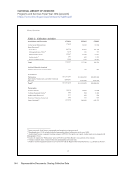104 Representative Documents: Policies and Procedures
UNIVERSITY OF MANITOBA LIBRARIES
Collection Evaluation for Programme and Course Changes, Academic Programme Reviews…
http://www.umanitoba.ca/libraries/directors_office/images/305_Policy.pdf
305.4
SUPPORTING DOCUMENTATION
Where additional explanation or analysis is required, supporting materials may be
appended to the Library Statement Form and may include:
Introduction – The first paragraph should be a strong introduction and should
clearly state whether the Libraries have or do not have sufficient resources to
support the proposed course. Clearly indicate the funding required to bring the
collection up to an adequate level. If sources of funding exist, they should be
named, whether budget or gift funds.
Collection Measures – Some methods of gauging a collection’s appropriateness
may include: volume counts (comparison with peer institutions), bibliographic
checking, database searches, and journal lists. Collections Management staff will
assist with this work given sufficient time.
Analysis – The statement should provide a report on the measures selected. Results
of checking lists should be interpreted using the "UML standards for list checking"
(Appendix 5 in the UML Collection Assessment Guidelines, 1999
http://www.umanitoba.ca/libraries/units/collections/assessment_guidelines.html#A
ppendix%205 see Attachment 7). Where appropriate, results should be separated
by format: monographs, serials, maps, audio-visual, etc. Consider what might these
results reveal about the age or language of the collection the importance of serials
versus books to the discipline and the need for multiple copies or various editions.
Other Factors – Where appropriate, comment on the anticipated course enrollment,
the proximity of library resources to primary users and/or the accessibility (hours of
operation, etc.), whether the course is offered online, whether interdisciplinary
subjects are involved.
RESPONSIBILITIES
Responsibility of the Liaison Librarian
a. Submits to an academic department, upon request, an assessment of the UM
Libraries’ ability to support the resource needs of a proposed new or revised
course/programme. Submits upon request, an assessment of the Libraries’ ongoing
ability to support academic programmes.
b. Notifies the department immediately if not enough time has been allowed to
properly assess the resource needs of the proposed course/programme.
c. Indicates to the department when the assessment can be finished.
d. Consults with the department to discuss the proposal, to identify any special needs
for the course or programme, and to agree, if needed, upon a bibliography to use in
assessing library support.
e. In cases where the Libraries collections cannot support the proposal:
UNIVERSITY OF MANITOBA LIBRARIES
Collection Evaluation for Programme and Course Changes, Academic Programme Reviews…
http://www.umanitoba.ca/libraries/directors_office/images/305_Policy.pdf
305.4
SUPPORTING DOCUMENTATION
Where additional explanation or analysis is required, supporting materials may be
appended to the Library Statement Form and may include:
Introduction – The first paragraph should be a strong introduction and should
clearly state whether the Libraries have or do not have sufficient resources to
support the proposed course. Clearly indicate the funding required to bring the
collection up to an adequate level. If sources of funding exist, they should be
named, whether budget or gift funds.
Collection Measures – Some methods of gauging a collection’s appropriateness
may include: volume counts (comparison with peer institutions), bibliographic
checking, database searches, and journal lists. Collections Management staff will
assist with this work given sufficient time.
Analysis – The statement should provide a report on the measures selected. Results
of checking lists should be interpreted using the "UML standards for list checking"
(Appendix 5 in the UML Collection Assessment Guidelines, 1999
http://www.umanitoba.ca/libraries/units/collections/assessment_guidelines.html#A
ppendix%205 see Attachment 7). Where appropriate, results should be separated
by format: monographs, serials, maps, audio-visual, etc. Consider what might these
results reveal about the age or language of the collection the importance of serials
versus books to the discipline and the need for multiple copies or various editions.
Other Factors – Where appropriate, comment on the anticipated course enrollment,
the proximity of library resources to primary users and/or the accessibility (hours of
operation, etc.), whether the course is offered online, whether interdisciplinary
subjects are involved.
RESPONSIBILITIES
Responsibility of the Liaison Librarian
a. Submits to an academic department, upon request, an assessment of the UM
Libraries’ ability to support the resource needs of a proposed new or revised
course/programme. Submits upon request, an assessment of the Libraries’ ongoing
ability to support academic programmes.
b. Notifies the department immediately if not enough time has been allowed to
properly assess the resource needs of the proposed course/programme.
c. Indicates to the department when the assessment can be finished.
d. Consults with the department to discuss the proposal, to identify any special needs
for the course or programme, and to agree, if needed, upon a bibliography to use in
assessing library support.
e. In cases where the Libraries collections cannot support the proposal:




















































































































































































